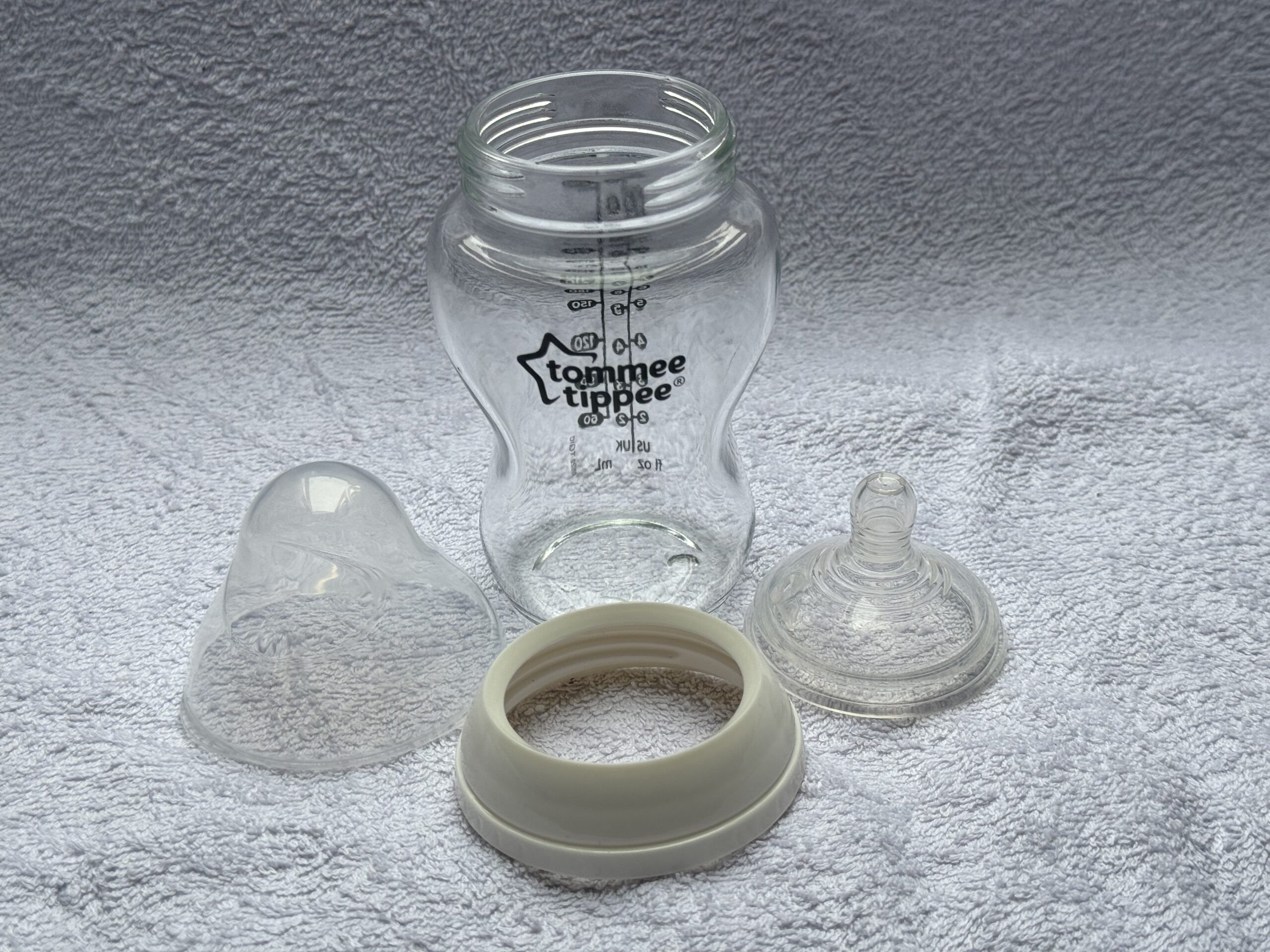Tommee Tippee Glass Baby Bottle Tested Positive for Three Toxicants (Heavy Metals) at Trace Levels (“Safe by All Current Standards”)
For those new to the Lead Safe Mama website:
Tamara Rubin is a multiple-federal-award-winning independent advocate for childhood Lead poisoning prevention and consumer goods safety, and a documentary filmmaker. She is also a mother of Lead-poisoned children (two of her four sons were acutely Lead-poisoned in 2005).
- Tamara owns and runs Lead Safe Mama, LLC — a unique community collaborative woman-owned small business for childhood Lead poisoning prevention and consumer goods safety.
- Since 2009, Tamara has been conducting XRF testing (a scientific testing method) using the exact instrumentation employed by the U.S. Consumer Product Safety Commission to test consumer goods for toxicants (specifically heavy metals — including Lead, Cadmium, Mercury, Antimony, and Arsenic).
- Since July of 2022, the work of Lead Safe Mama, LLC has been responsible for 5 product recalls (FDA and CPSC).
- All test results reported on this website are science-based, accurate, and replicable.
- Items that Lead Safe Mama, LLC reports on are tested multiple times to confirm the results published (for each component tested).
- Recent notable press… There has been too much to mention already in 2024! Please check out our press page to see some of the amazing coverage of our work so far this year!
Section #1) This article has full XRF test results for each component of a Tommee Tippee glass baby bottle.
Please scroll down to read the test results for each component of this bottle. There are FIVE sets of test results listed below:
#1) the painted area of the exterior of the glass of the bottle
#2) the unpainted glass of the bottle
#3) the clear silicone nipple of the bottle
#4) the white plastic collar of the bottle, and
#5) the clear plastic cap that goes over the nipple.
Section #2) What do these results mean?
- This bottle tested positive for three concerning toxicants (as well as two other metals that are also considered unsafe, but which are less-widely evaluated for health impacts caused by their presence in consumer goods).
- The toxic metals were generally found at “trace” (i.e. very low) levels — levels that are considered to be safe by all U.S. and European standards.
- Cadmium — a known carcinogen — was found in both the glass of the Tommee Tippee baby bottle and in the silicone nipple.
- Lead — a neurotoxin — was found in the black painted logo and measurement markings on the bottle.
- Traces of Antimony (also a known carcinogen) were found in the glass of the bottle and also in the silicone nipple.
- Titanium (recently banned for use in food in Europe) was found in the black painted markings and the white plastic collar (the Titanium in the plastic is not particular concerning in this application). Titanium is often a colorant for white items and is also a primary base component for most modern paints.
- Cobalt was also found in the black painted markings (Cobalt is often present in large quantities as a primary colorant ingredient for black or blue paint).
Section #3) How much Lead is too much Lead?
Is this much Lead a problem?
What about the level of Antimony found? And the level of Cadmium?
For context, it is important to understand that there is no safe level of Lead exposure for children; the allowable level of Lead in the paint, glaze, or coating of an item intended for use by children (as set by the Consumer Product Safety Improvement Act of 2008) is 90 ppm Lead. Any item (intended for use by children) with levels up to 90 ppm Lead in the paint, glaze, or coating is considered legal and safe by modern standards. That said, there are Lead-free glass baby bottles and there’s no reason that — in 2024 — any baby bottle should have any amount of Lead in the coating or painted markings. There are truly Lead-free paint options available (for logos and measurement markings) — and there are also many brands that produce their baby bottles with embossed (pressed into the glass) markings as an alternative to painted coatings — so each of these are clearly-viable manufacturing options.
As far as the levels of Cadmium are concerned, Cadmium is found (in at least trace amounts) in most modern silicone products (regardless of the color of the silicone). Accordingly, it is not unexpected at all to find trace Cadmium (at levels considered safe by all standards) in a silicone baby bottle nipple. While these levels are not unusual (and are currently considered safe), the staggering prevalence of silicone products being used to feed children these days raises a bit of concern about the potential for increased total aggregate Cadmium exposure… and because of this, we recommend avoiding silicone for feeding options whenever possible. If your baby will only take a silicone nipple, please feel confident about feeding your baby with a silicone nipple — but try to avoid food-use silicone elsewhere in your child’s life. (Note: If your baby will take a natural rubber nipple instead, that’s an excellent alternative.)
While not ideal, the levels of Antimony and Cadmium found in the glass of the bottle are not particularly concerning — as they are likely “locked” in the glass at those very low levels, and would not be expected to leach, even with heavy use.
Section #4) “But Tamara, I saw testing that someone else did and they got different results. Why is that?”
First, I want to acknowledge and express my gratitude for the fact that — this year — others have joined the movement of testing baby bottles for Lead (to help raise awareness of the concern), creating a groundswell of new interest that will hopefully (eventually) get these toxic children’s products banned from production!
Compared to others doing additional baby bottle testing, some might feel that the position of Lead Safe Mama, LLC is “extreme” — in that we are calling products that test positive for Lead within the legal “safe range,” toxic/ potentially unsafe (even though they may comply with current federal standards). Please know that in doing this, we are adhering to first principles of caring for children (“First, do no harm”), combined with the best available science (which is often stricter than current federal regulatory standards — as it is in this case). The clear consensus in the scientific community is that there is “NO ‘SAFE’ LEVEL OF LEAD EXPOSURE FOR CHILDREN.” This is not a point of contention. (Watch this video to see how much Lead it takes to poison a child.) We mention this because we have noticed that others who are doing baby bottle testing have been consistently dismissive of low levels of Lead in the paint on these bottles, when that is truly an irresponsible approach to finding any amount of Lead in a child-accessible component of a baby bottle.
With that introduction, I want to emphasize and clarify a few points:
- I have been testing baby bottles for toxicants using XRF technology since 2009, and in doing so have more experience with this than probably anyone else on the planet at this point.
- I spend a minimum of one-hour testing any given baby bottle (and sometimes as much as two or three hours testing a single bottle).
- The reason I take so much time is that I want to make sure any test results we publish here on LeadSafeMama.com are science-based and fully replicable. If we cannot get the exact same result twice (or more) within a reasonable margin of error for each and every component of the bottle, we will not publish the results.
- We also fully calibrate our instrument before any testing we do — this ensures we are starting from a good baseline.
- We also make sure there is no contamination (potentially toxicant-containing dust) on the surface of the scope of the instrument.
- We always test in a Lead-free environment and against a metals-free background.
- We also test for at least 60 seconds (one minute) per test (again, repeated multiple times) if we find the presence of toxicants in the initial/ preliminary testing.
- When we do find toxicants, we repeat the testing up to 3-minutes each to confirm the results before publishing them.
What we are seeing with others testing online (using various testing methodologies) include the following concerns that may result in “their findings” appearing to differ from ours:
- They are not testing in a scientifically clean environment (there may be Lead contamination from other sources in their environment — at the micro-dust level, which could throw off their readings).
- They are not testing against a known Lead-free/ neutral/ metals-free surface. This could result in the surface being used for testing throwing off the test results in some way (possibly diluting the reading — or even potentially contaminating the reading with higher levels of a substance being detected).
- The others doing testing that I have seen (in video formats on social media) are doing only short tests (5 or 10 seconds each, typically), not normally longer tests to make sure the results found (and published) are as accurate as possible (and to make sure the margin of error is as small as possible).
- They do not appear to be repeating the test multiple times before declaring/ publishing/ announcing/ sharing the levels of toxicants found.
- With considerations 1 through 4 above, they may come up with test results that are artificially “high” for toxicants.
- Alternately, they may not be looking for optimal placement of the testing window of the XRF instrument on the item, so readings may be coming up as artificially “low” for toxicants.
All of these reasons could skew the test results, making a person’s results for the same item we are testing significantly different than our findings. Given the nature of our findings, and given the fact that we stand by the testing we do 100%, we only publish findings that we are 100% confident in. We (Lead Safe Mama, LLC) also have a significant amount of risk were we to publish findings that are not accurate or true. Given the nature of our work (calling companies out for using heavy metals and potentially poisoning children and others), we are not able to secure liability insurance (in terms of errors and omissions insurance specifically) — so we also have way too much to lose were we to publish false or questionable (or even simply non-replicable findings!).
Section #5) “But Tamara, you bought this bottle last year… do these results hold true for bottles purchase this year?”
Year of purchase does not really matter (given — with the category of Baby Bottles specifically — these are all relatively new products). When in doubt, extrapolate based on the existing data available:
- For baby bottles that test positive for toxicants, it is safe to assume the same bottles (made by the same brand and of the same materials) are positive for those toxicants (at the levels found) across all years unless otherwise demonstrated by independent testing.
- For bottles from brands that consistently test negative for toxicants, it is safe to assume that newer bottles (currently available for purchase today) test similarly well to bottles made by the same brands (of the same materials) as bottles made previously by that brand.
There are a few exceptions to this (brand new glass bottles from NUK have been testing negative for Lead as the company switched their paint formulation in response to our earlier findings of high levels of Lead in the paint on their bottles, for example), but we will always state the exceptions in our summaries and reports — so we do encourage you to read the full report on each of the bottles you are interested in. (You can also read the introduction to our Lead Safe Mama Baby Bottle Guide, which is linked at the top of every page on the website — but can also be found here, at this link).
Section #6) “My baby has been using this bottle. Are they Lead-poisoned as a result of this? What should I do now?”
While (again) all federal agencies agree there is no safe level of Lead exposure for children, and that it only takes a microscopic amount of Lead to poison a child, it is unlikely that a baby bottle with Lead-contaminated paint that tests positive in the range of 49 ppm to 61 ppm Lead (as this Tommee Tippee bottle does) will result in an elevated Blood Lead Level (BLL) for a child. That said, if you are ever concerned about potential Lead exposure for your child, it is always best to rely on science. Worrying and guessing does not help, as it does not give you answers. Getting a BLL test for your child will help and will give you context and answers. If the paint on your baby’s Tommee Tippee bottle is worn or deteriorating in any way (from multiple sterilizations/ washings/ boiling), a BLL test is definitely warranted (especially for primarily bottle-fed babies and for babies who hold their own bottles — and especially if your baby has not yet has a BLL test and is approaching crawling age).
Here are some additional related articles to read before you get your child tested for Lead:
- What should I do if I think my child might have been exposed to a small amount of Lead?
- Everything you need to know before you bring your child in for a Blood Lead Level test.
- What it means when you get a “Less Than” result for your child’s BLL (like “less than 3” or “less than 1”)
- My doctor told me my child’s BLL is “normal”, what does that mean?
- I am concern to get my child tested as they are afraid of needles. Can I infer their BLL from mine if I get myself tested?
- What’s the safest way to detox my child if I think they may have been exposed to Lead?
Section #7) For truly Lead-free bottles, here are some better choices
Some might argue that, “there is ‘a little Lead in everything’” in the modern age, because of global pollution from the mining, refining, and manufacturing of Lead, as well as all the resultant products made with Lead. This is a false argument; it is simply not true. There are Lead-free alternatives for absolutely everything out there. (One just has to take a moment and look at available options before a purchase, relying on independent science rather than all the irrelevant chatter from opportunistic “influencers” who are selling the contaminated products — blatant conflict of interest (!) — or simply following the news cycle and making snarky videos dismissing legitimate concerns for your entertainment and their profit!) Here are some baby bottles that we have consistently found to be Lead-free (over multiple years of testing/ testing multiple options from these brands):
Lead-free choices from Avent
Glass: $39.95 for an 8 oz set of four: https://amzn.to/49l7vt1
Glass: $39.95 for a 4 oz set of four: https://amzn.to/49NlmrT
Plastic: $26.65 for a 9 oz set of four: https://amzn.to/3Ie1fHe
–
Lead-free choices from LifeFactory
Glass: $14.99, single 4 oz: https://amzn.to/3T51z1s
Glass: $26.93, two-pack, 4 oz: https://amzn.to/49KlfNo
Glass: $29.60, two-pack, 9 oz: https://amzn.to/42Rcsr6
–
Lead-free choices from EvenFlo
Glass: $16.27, six-pack, 8 oz: https://amzn.to/48nRocF
Plastic: $29.99, six-pack, 9 oz: https://amzn.to/3wqVSlw
–
Lead-free choices from Dr. Brown
Glass: $18.95, three-pack, 5 oz: https://amzn.to/3PfJnQz
Glass: $18.95, three-pack, 9 oz: https://amzn.to/3OSeX6K
–
Lead-free choices from Haakaa
Glass: $19.90, single bottle, 4.2 oz: https://amzn.to/3I50j8l
Amazon links are affiliate links. If you purchase something after clicking a Lead Safe Mama, LLC affiliate link, Lead Safe Mama, LLC may receive a percentage of what you spend at no extra cost to you.
Section #8) Full XRF test results for the bottle pictured
Reading #1) Logo Markings
90-second test
- Lead (Pb): 55 +/- 6 ppm
- Cadmium (Cd): 19 +/- 4 ppm (likely from glass substrate)
- Antimony (Sb): 18 +/- 9 ppm (likely from glass substrate)
- Titanium (Ti): 3.461 +/- 693 ppm
- Chromium (Cr): 5,895 +/- 335 ppm
- Iron (Fe): 170 +/- 68 ppm
- Cobalt (Co): 1,318 +/- 75 ppm
- Copper (Cu): 1,342 +/- 54 ppm
- Zinc (Zn): 8593 +/- 159 ppm
- Zirconium (Zr): 957 +/- 19 ppm
- Niobium (Nb): 479 +/- 15 ppm
- Indium (In): 26 +/- 5 pppm
- No other metals were detected.
Reading #2) Unpainted Glass
60-second test
- Cadmium (Cd): 25 +/- 5 ppm
- Antimony (Sb): 25 +/- 11 ppm
- Iron (Fe): 280 +/- 97 ppm
- Zirconium (Zr): 846 +/- 22 ppm
- Niobium (Nb): 655 +/- 22 ppm
- Indium (In): 31 +/- 7 ppm
- Tin (Sn): 19 +/- 8 ppm
- Platinum (Pt): 51 +/- 29 ppm
- No other metals were detected.
Reading #3) Clear Silicone Nipple
90-second test
- Cadmium (Cd): 16 +/- 4 ppm
- Antimony (Sb): 21 +/- 8 ppm
- Zinc (Zn): 45 +/- 10 ppm
- Niobium (Nb): 487 +/- 15 ppm
- Indium (In): 20 +/- 5 ppm
- Tin (Sn): 11 +/- 6 ppm
- No other metals were detected.
 Reading #4) White Plastic Collar/ Ring
Reading #4) White Plastic Collar/ Ring
30-second test
- Titanium (Ti): 5,430 +/- 488 pm
- No other metals were detected.
 Reading #5) Clear Plastic Nipple Cap
Reading #5) Clear Plastic Nipple Cap
30-second test
- No metals detected.
~ End ~
Additional photos of the bottle tested are below.
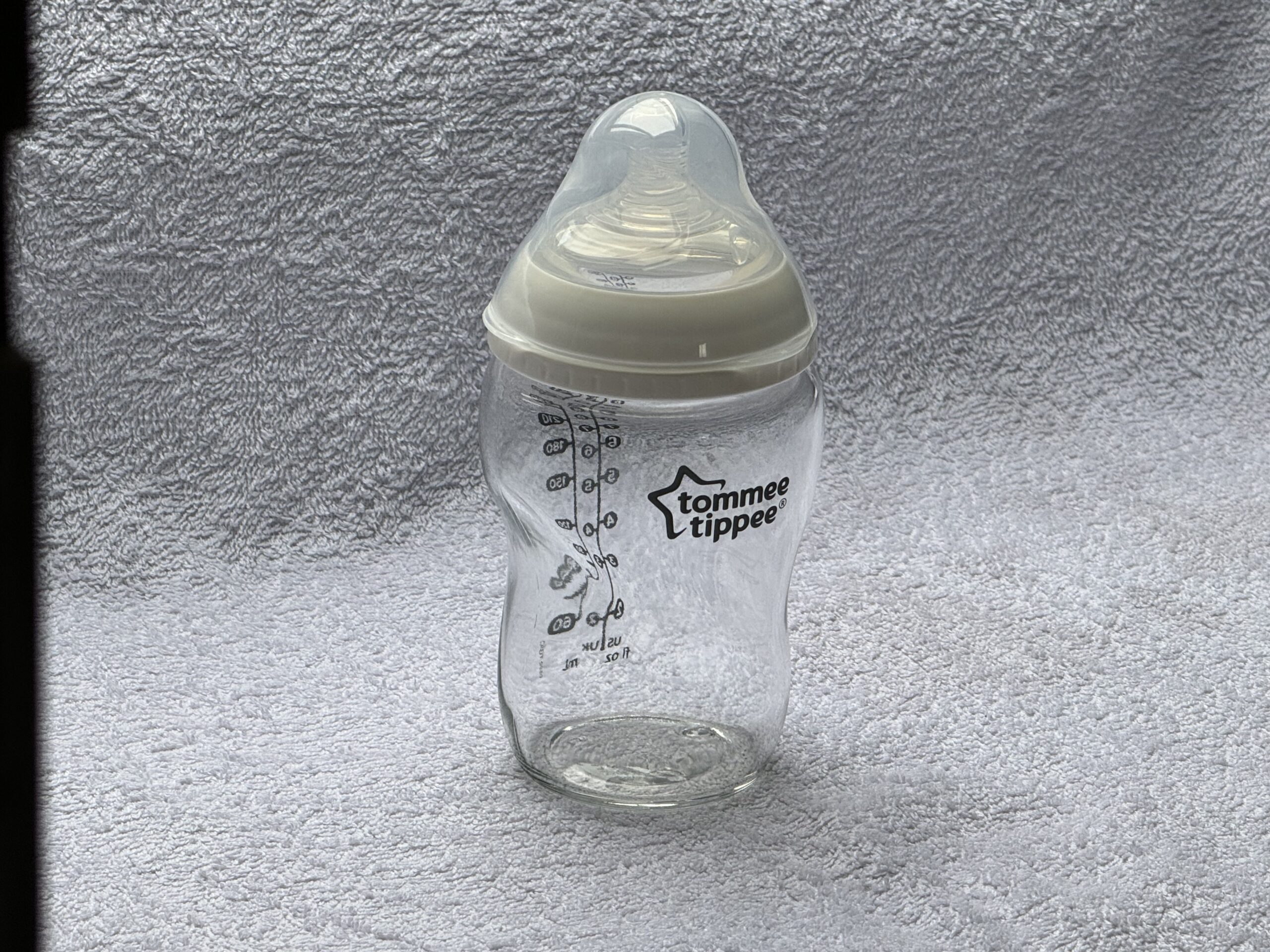
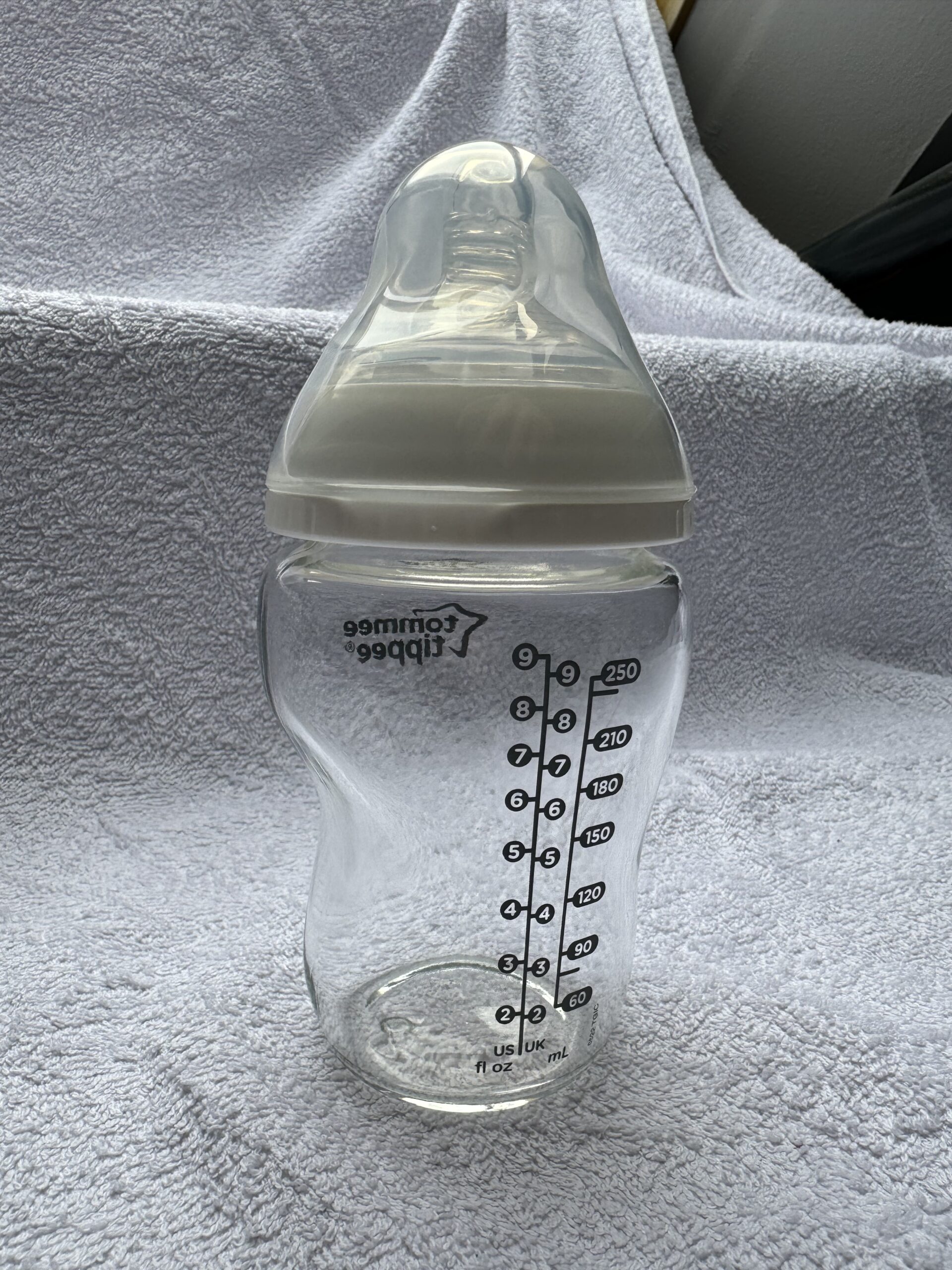

Never Miss an Important Article Again!
Join our Email List


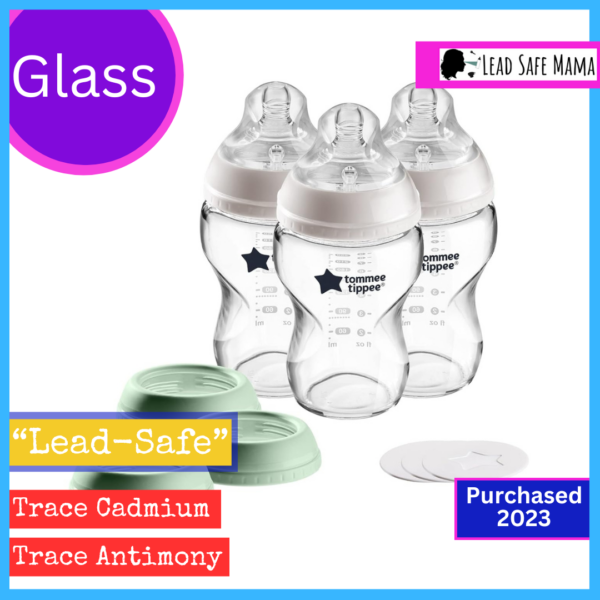






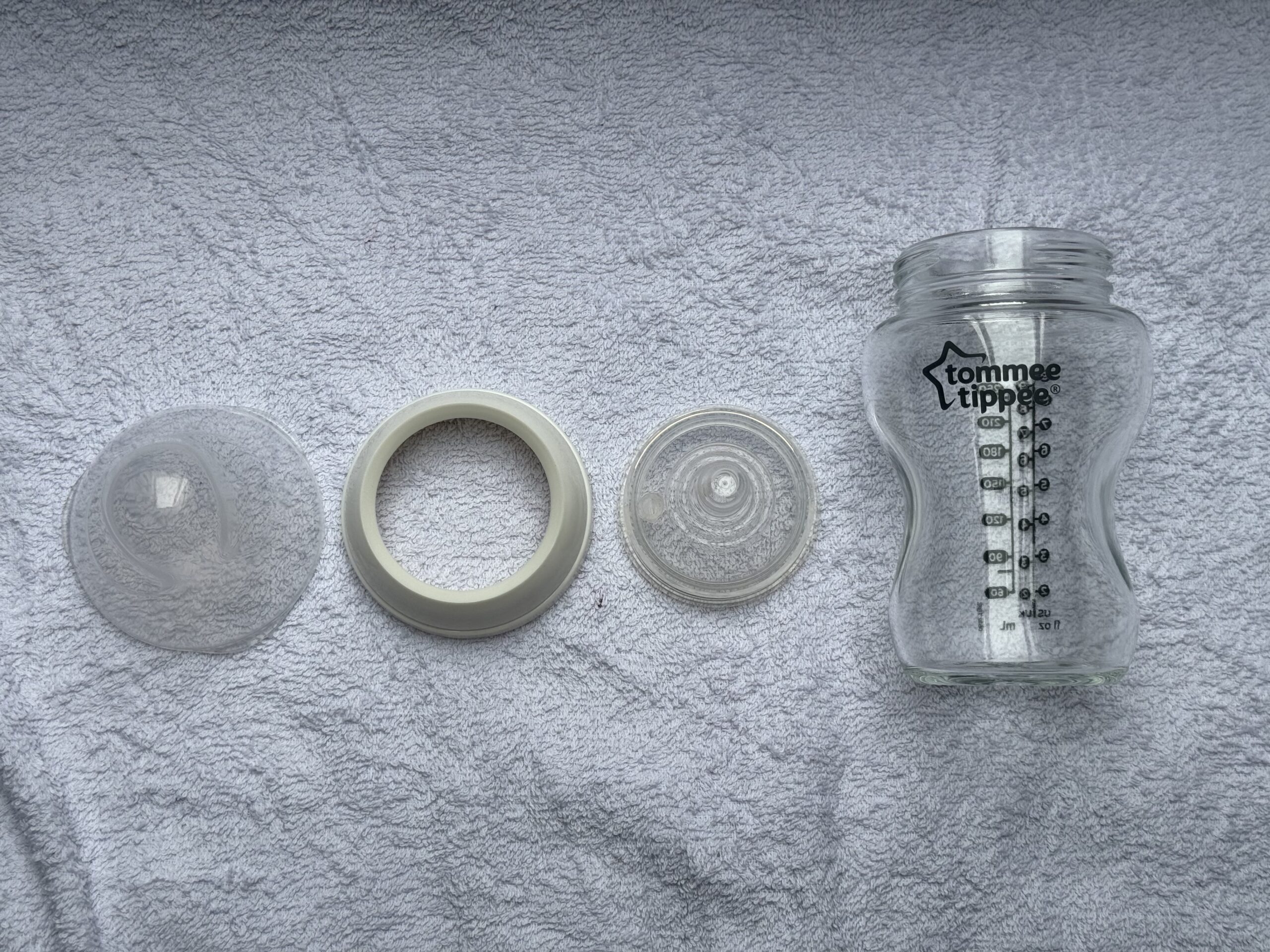
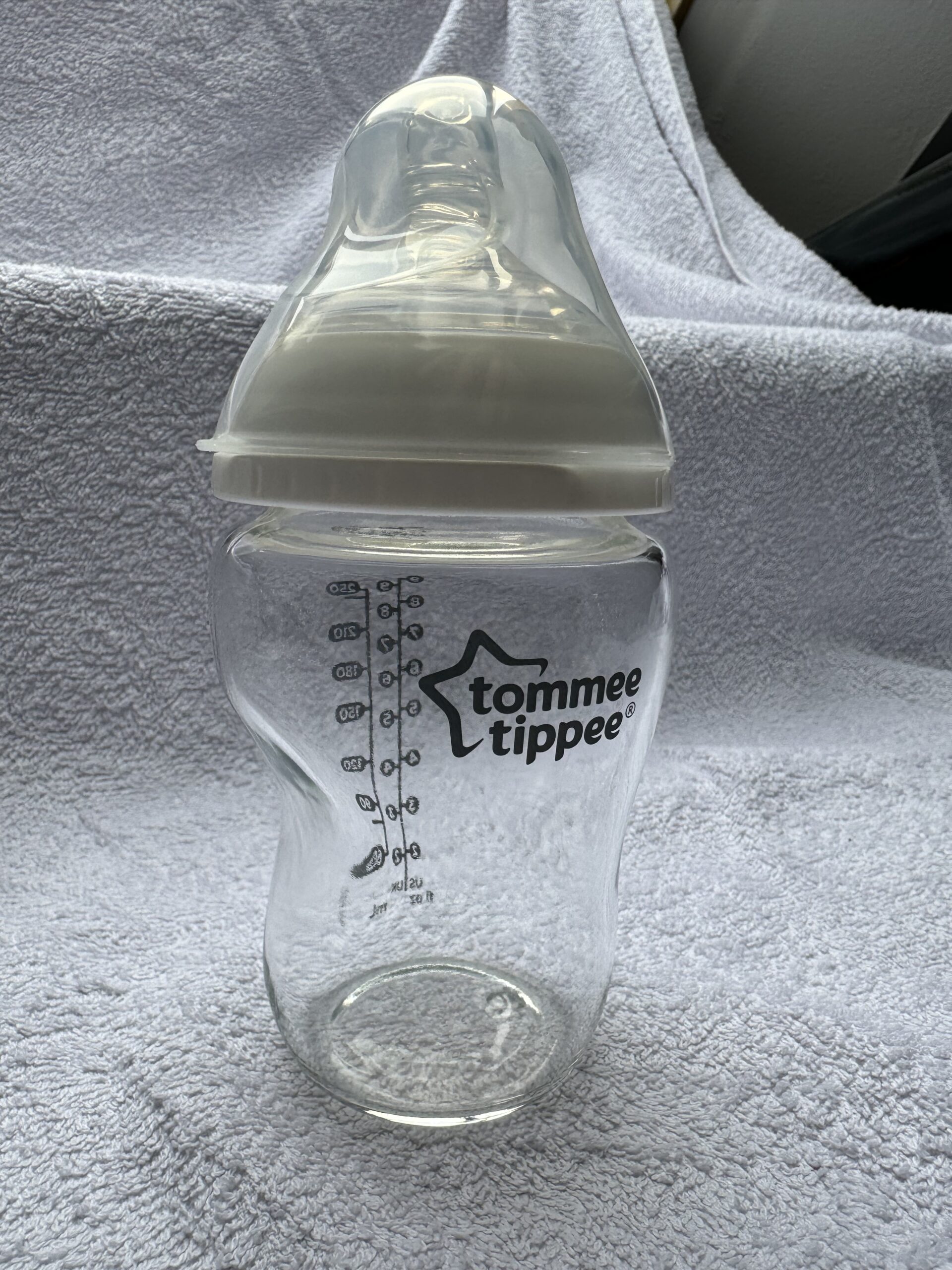
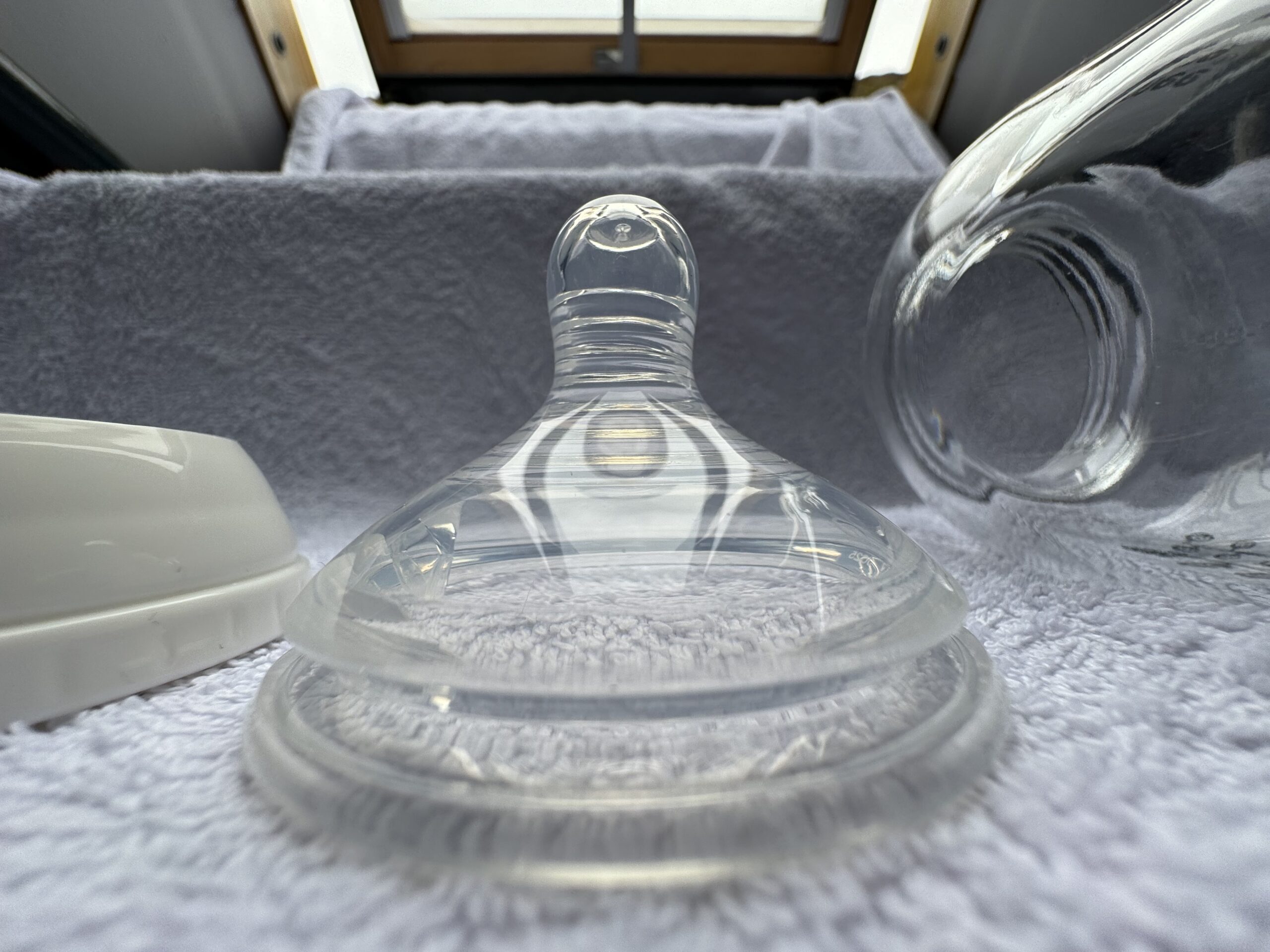
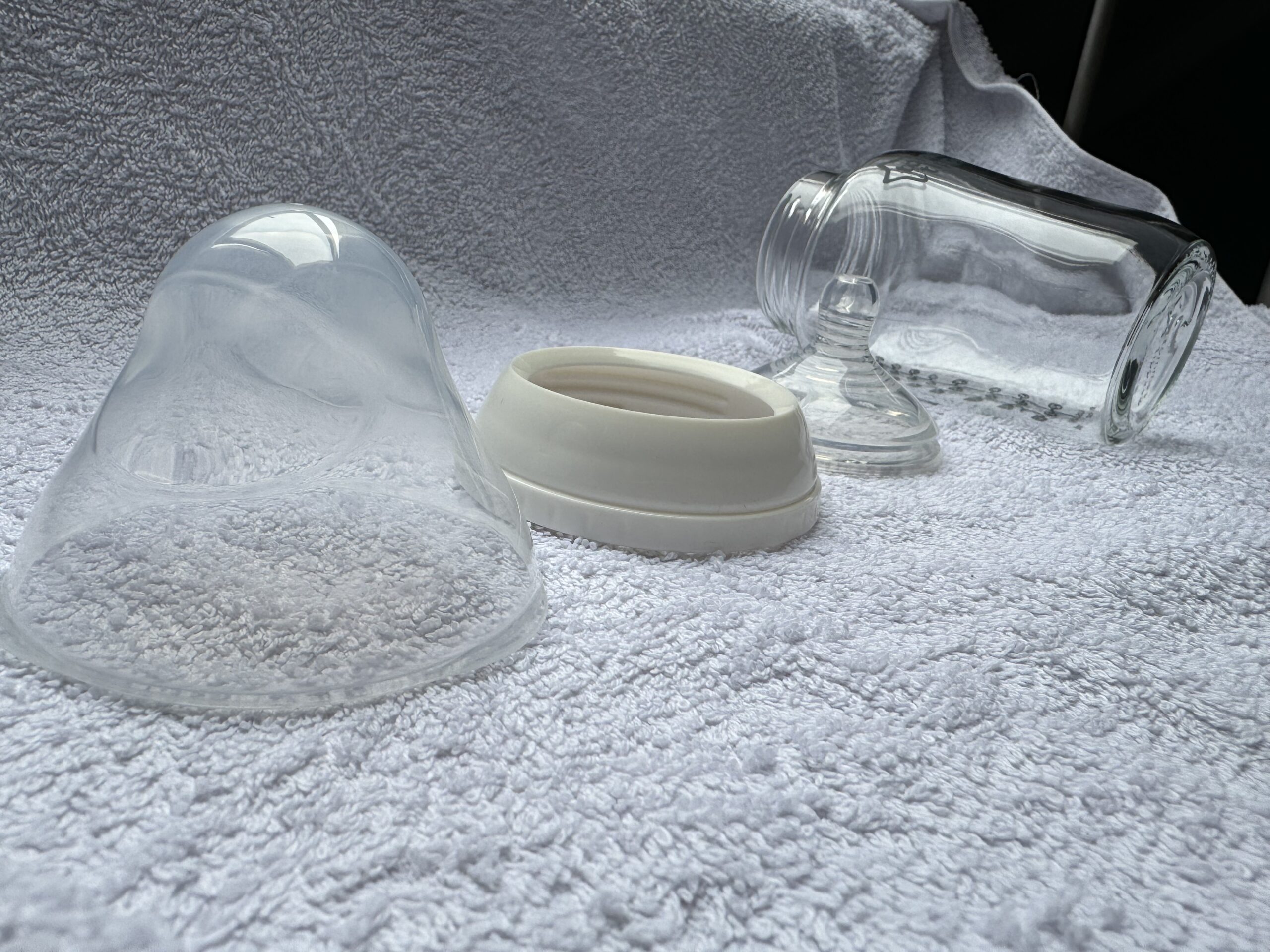 Reading #4) White Plastic Collar/ Ring
Reading #4) White Plastic Collar/ Ring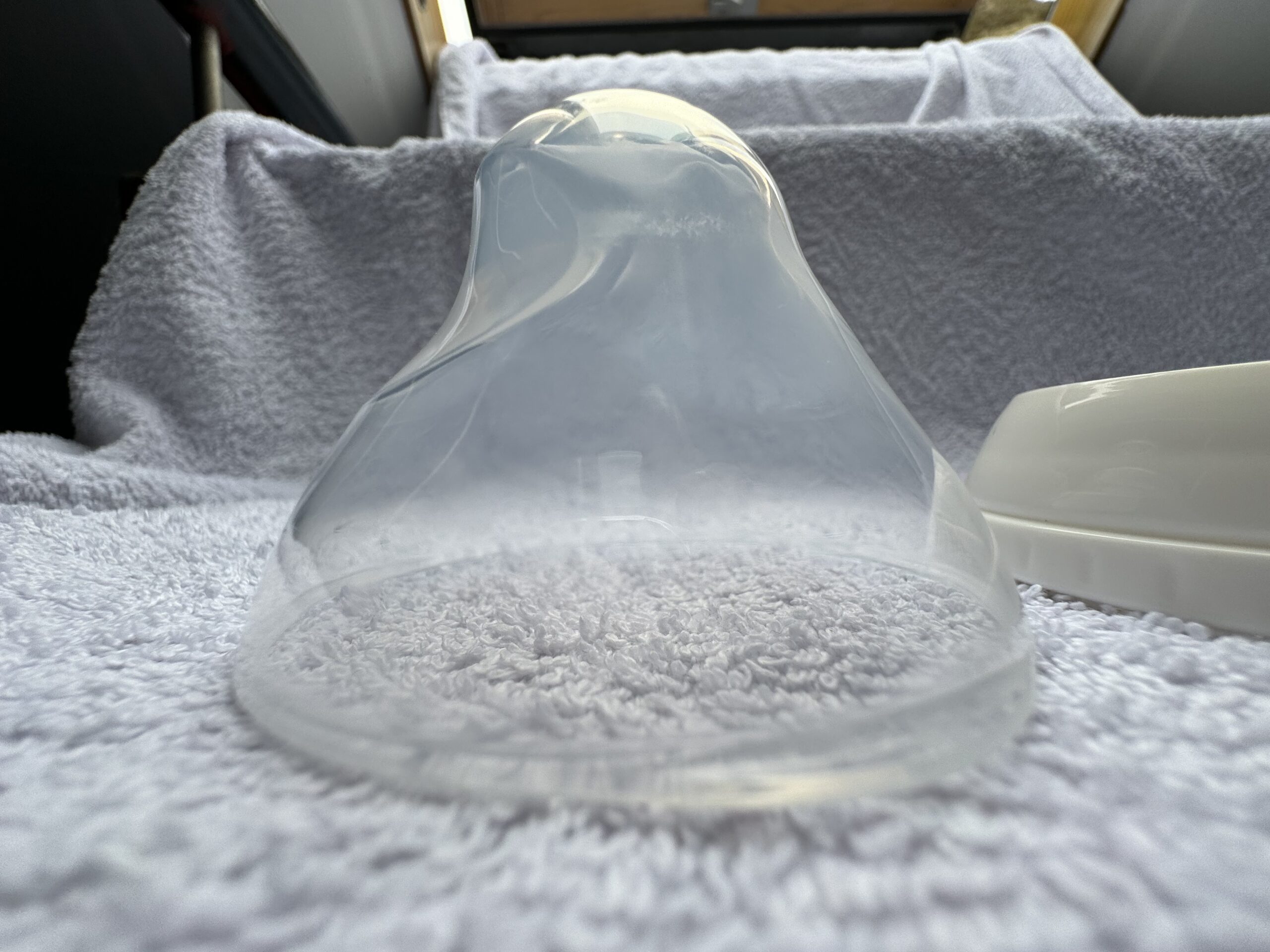 Reading #5) Clear Plastic Nipple Cap
Reading #5) Clear Plastic Nipple Cap